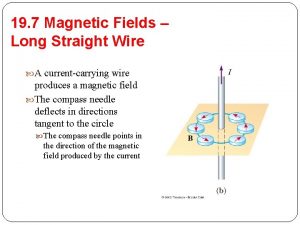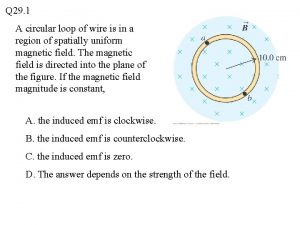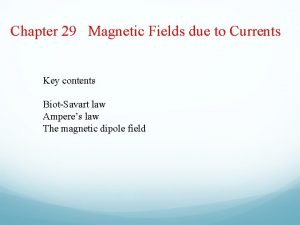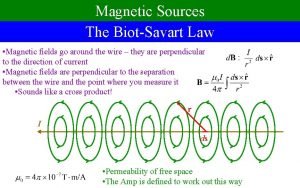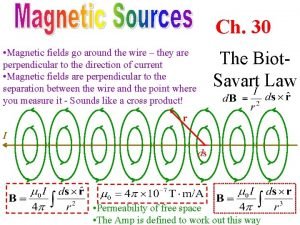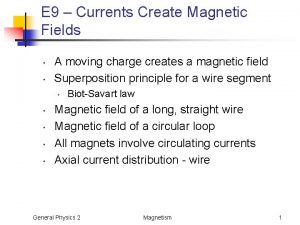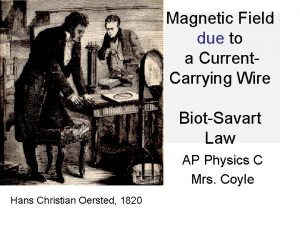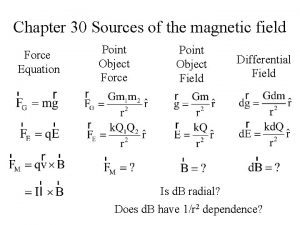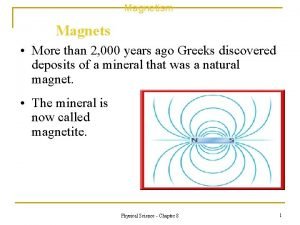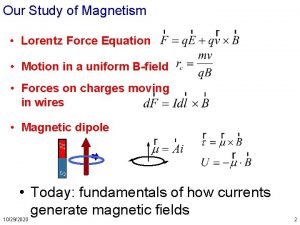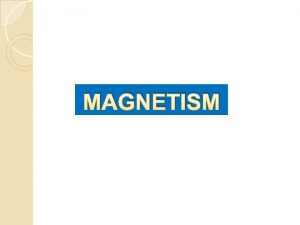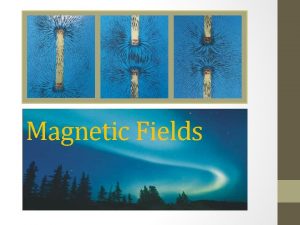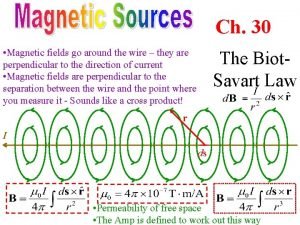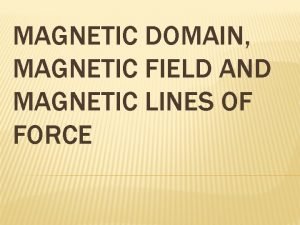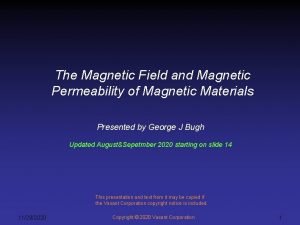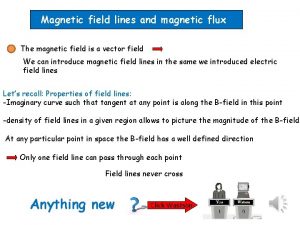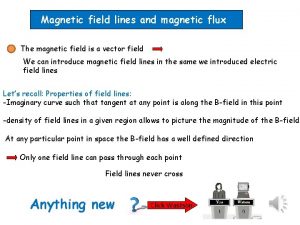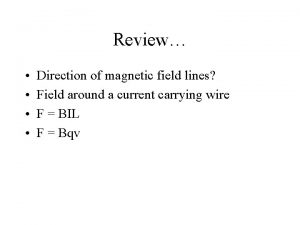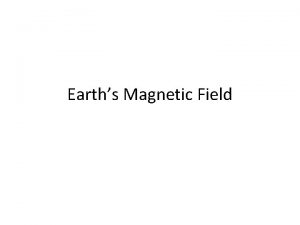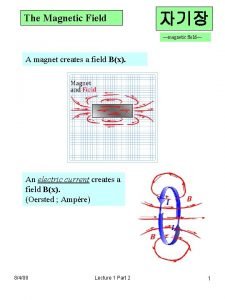Magnetic field around a straight wire Magnetic Field



















- Slides: 19

Magnetic field around a straight wire

Magnetic Field of Two Wires Field at points on the x-axis to the right of point (3) Magnetic field outside of a conductor pair falls off more rapidly

Magnetic field of a circular arc

Magnetic Field of a Circular Current Loop Falls off just as the electric field of the electric dipole Magnetic Field on the Axis of a Coil

The magnetic field of a (small) loop behaves “on the outside” like the electric field of the electric dipole of the same orientation – that’s why “magnetic dipole”.

Magnetic force between two parallel conductors with currents

Example: Two straight, parallel, superconducting wires 4. 5 mm apart carry 15, 000 A current each in opposite directions Should we carry about the mechanical strength of the wires?

Ampere’s Law

General Statement Magnetic fields add as vectors, currents – as scalars

Just as with the integral form of Gauss’s law, the integral form of Ampere’s law is powerful to use in symmetric situations

Magnetic Field of a Solenoid

Field of a toroidal solenoid

Magnetic Field of a Sheet of Current The field of a magnetic “capacitor”

Magnetic materials When materials are placed in a magnetic field, they get magnetized. In majority of materials, the magnetic effects are small. Some however show strong responses. The small magnetism is of two kinds: • Diamagnetics are repelled from magnetic fields • Paramagnetics are attracted towards magnetic fields This is unlike the electric effect in matter, which always causes dielectrics to be attracted.

The Bohr Magnetron

Magnetization

• Diamagnetism occurs in substances where magnetic moments inside atoms all cancel out, the net magnetic moment of the atom is zero. The induced magnetic moment is directed opposite to the applied field. Diamagnetism is weakly dependent on T. • Diamagnetic (induced atomic moment) effect is overcome in paramagnetic materials, whose atoms have uncompensated magnetic moments. These moments align with the applied field to enhance the latter. Temperature T wants to destroy alignment, hence a strong (1/T) dependence. Magnetic effects are a completely quantum-mechanical phenomenon, although some classical physics arguments can be made.

Example: Magnetic dipoles in a paramagnetic material Nitric oxide (NO) is a paramagnetic compound. Its molecules have maximum magnetic moment of ~ m. B. In a magnetic field B=1. 5 Tesla, compare the interaction energy of the magnetic moments with the field to the average translational kinetic energy of the molecules at T=300 K.

Ferromagnetism • In ferromagnetic materials, in addition to atoms having uncompensated magnetic moments, these moments strongly interact between themselves. • Strongly nonlinear behavior with remnant magnetization left when the applied field is lifted. Permeability Km is much larger, ~1, 000 to 100, 000 Alignment of magnetic domains in applied field
 Magnetic field in long straight wire
Magnetic field in long straight wire A circular loop of wire is in a region of spatially uniform
A circular loop of wire is in a region of spatially uniform Electric field due to infinitely long straight wire
Electric field due to infinitely long straight wire Magnetic field outside a wire
Magnetic field outside a wire Magnetic field of a finite wire
Magnetic field of a finite wire Magnetic field of a finite wire
Magnetic field of a finite wire Magnetic field equation wire
Magnetic field equation wire Magnetic force
Magnetic force Magnetic field biot savart law
Magnetic field biot savart law Magnetic moment and magnetic field relation
Magnetic moment and magnetic field relation Air gap length formula
Air gap length formula F=i(lxb)
F=i(lxb) A single wire wrap into a cylindrical wire coil is called
A single wire wrap into a cylindrical wire coil is called Magnitude of magnetic force
Magnitude of magnetic force Difference between electric field and magnetic field
Difference between electric field and magnetic field Electric field and magnetic field difference
Electric field and magnetic field difference Lorentz force
Lorentz force Go straight on the street
Go straight on the street Examples of what goes around comes around
Examples of what goes around comes around Martin luther king of hinduism
Martin luther king of hinduism
